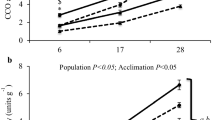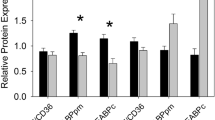Abstract
Both basal metabolic rate (BMR) and maximum lifespan potential (MLSP) vary with body size in mammals and birds and it has been suggested that these are mediated through size-related variation in membrane fatty acid composition. Whereas the physical properties of membrane fatty acids affect the activity of membrane proteins and, indirectly, an animal’s BMR, it is the susceptibility of those fatty acids to peroxidation which influence MLSP. Although there is a correlation between body size and MLSP, there is considerable MLSP variation independent of body size. For example, among bird families, Galliformes (fowl) are relatively short-living and Psittaciformes (parrots) are unusually long-living, with some parrot species reaching maximum lifespans of more than 100 years. We determined BMR and tissue phospholipid fatty acid composition in seven tissues from three species of parrots with an average MLSP of 27 years and from two species of quails with an average MLSP of 5.5 years. We also characterised mitochondrial phospholipids in two of these tissues. Neither BMR nor membrane susceptibility to peroxidation corresponded with differences in MLSP among the birds we measured. We did find that (1) all birds had lower n-3 polyunsaturated fatty acid content in mitochondrial membranes compared to those of the corresponding tissue, and that (2) irrespective of reliance on flight for locomotion, both pectoral and leg muscle had an almost identical membrane fatty acid composition in all birds.




Similar content being viewed by others
References
Abbott SK, Else PL, Hulbert AJ (2010) Membrane fatty acid composition of rat skeletal muscle is most responsive to the balance of dietary n-3 and n-6 PUFA. Br J Nutr 103:522–529
Arnold TW (1988) Life histories of North American game birds: a reanalysis. Can J Zool 66:1906–1912
Baeza E, Chartrin P, Meteau K, Bordeau T, Juin H, Le Bihan-Duval E, Lessire M, Berri C (2010) Effect of sex and genotype on carcase composition and nutritional characteristics of chicken meat. Br Poult Sci 51:344–353
Brand MD, Turner N, Ocloo A, Else PL, Hulbert AJ (2003) Proton conductance and fatty acyl composition of liver mitochondria correlates with body mass in birds. Biochem J 376:741–748
Brouwer K, Jones ML, King CE, Schifter H (2007) Longevity records for Psittaciformes in captivity. Int Zoo Yearb 37:299–316
Buttemer WA, Warne S, Bech C, Astheimer LB (2008) Testosterone effects on avian basal metabolic rate and aerobic performance: facts and artefacts. Comp Biochem Physiol A Mol Integr Physiol 150:204–210
Clemens MR, Waller HD (1987) Lipid peroxidation in erythrocytes. Chem Phys Lipids 45:251–268
Couture P, Hulbert AJ (1995) Membrane fatty acid composition of tissues is related to body mass of mammals. J Membr Biol 148:27–39
Gornall AG, Bardawill CJ, David MM (1949) Determination of serum proteins by means of the biuret reaction. J Biol Chem 177:751–766
Gudbjarnason S, Doell B, Oskarsdottir G (1978) Docosahexaenoic acid in cardiac metabolism and function. Acta Biol Med Ger 37:777–784
Guglielmo CG, Williams TD, Zwingelstein G, Brichon G, Weber JM (2002) Plasma and muscle phospholipids are involved in the metabolic response to long-distance migration in a shorebird. J Comp Physiol B Biochem Syst Environ Physiol 172:409–417
Gutierrez AM, Reboredo GR, Mosca SM, Catala A (2006) A low degree of fatty acid unsaturation leads to high resistance to lipid peroxidation in mitochondria and microsomes of different organs of quail (Coturnix coturnix japonica). Mol Cell Biochem 282:109–115
Holman RT (1954) Autoxidation of fats and related substances. Pergamon Press, London
Holmes DJ, Fluckiger R, Austad SN (2001) Comparative biology of aging in birds: an update. Exp Gerontol 36:869–883
Hulbert AJ (2008) The links between membrane composition, metabolic rate and lifespan. Comp Biochem Physiol A Mol Integr Physiol 150:196–203
Hulbert AJ (2010) Metabolism and longevity: is there a role for membrane fatty acids? Integr Comp Biol 50:808–817
Hulbert AJ, Beard LA, Grigg GC (2008) The exceptional longevity of an egg-laying mammal, the short-beaked echidna (Tachyglossus aculeatus) is associated with peroxidation-resistant membrane composition. Exp Gerontol 43:729–733
Hulbert AJ, Else PL (1999) Membranes as possible pacemakers of metabolism. J Theor Biol 199:257–274
Hulbert AJ, Else PL (2000) Mechanisms underlying the cost of living in animals. Annu Rev Physiol 62:207–235
Hulbert AJ, Faulks S, Buttemer WA, Else PL (2002a) Acyl composition of muscle membranes varies with body size in birds. J Exp Biol 205:3561–3569
Hulbert AJ, Faulks SC, Harper JM, Miller RA, Buffenstein R (2006a) Extended longevity of wild-derived mice is associated with peroxidation-resistant membranes. Mech Ageing Dev 127:653–657
Hulbert AJ, Faulks SC, Buffenstein R (2006b) Oxidation-resistant membrane phospholipids can explain longevity differences among the longest-living rodents and similarly-sized mice. J Gerontol A Biol Sci Med Sci 61:1009–1018
Hulbert AJ, Pamplona R, Buffenstein R, Buttemer WA (2007) Life and death: metabolic rate, membrane composition, and life span of animals. Physiol Rev 87:1175–1213
Hulbert AJ, Rana T, Couture P (2002b) The acyl composition of mammalian phospholipids: an allometric analysis. Comp Biochem Physiol B Biochem Mol Biol 132:515–527
Hulbert AJ, Trzcionka M, Buttemer WA (2010) Membrane fatty acid composition and longevity of mammals and birds. In: Pamplona R, Barja G (eds) Longevity, mitochondria and oxygen free radicals. Research Signpost, Kerala, pp 79–93
Infante JP, Kirwan RC, Brenna JT (2001) High levels of docosahexaenoic acid (22:6n–3)-containing phospholipids in high-frequency contraction muscles of hummingbirds and rattlesnakes. Comp Biochem Physiol B Biochem Mol Biol 130:291–298
Lindstedt SL, Calder WA (1976) Body size and longevity in birds. Condor 78:91–94
Miller RA, Harper JM, Dysko RC, Durkee SJ, Austad SN (2002) Longer life spans and delayed maturation in wild-derived mice. Exp Biol Med (Maywood) 227:500–508
Pamplona R, Portero-Otin M, Riba D, Ruiz C, Prat J, Bellmunt MJ, Barja G (1998) Mitochondrial membrane peroxidizability index is inversely related to maximum life span in mammals. J Lipid Res 39:1989–1994
Pamplona R, Barja G, Portero-Otin M (2002) Membrane fatty acid unsaturation, protection against oxidative stress, and maximum life span: a homeoviscous-longevity adaptation? Ann N Y Acad Sci 959:475–490
Pamplona R, Portero-Otin M, Sanz A, Ayala V, Vasileva E, Barja G (2005) Protein and lipid oxidative damage and complex I content are lower in the brain of budgerigar and canaries than in mice. Relation to aging rate. Age (Dordr) 27:267–280
Picq M, Chen P, Perez M, Michaud M, Vericel E, Guichardant M, Lagarde M (2010) DHA metabolism: targeting the brain and lipoxygenation. Mol Neurobiol 42:48–51
Price ER, Guglielmo CG (2009) The effect of muscle phospholipid fatty acid composition on exercise performance: a direct test in the migratory white-throated sparrow (Zonotrichia albicollis). Am J Physiol Regul Integr Comp Physiol 297:R775–R782
Szabo A, Febel H, Mezes M, Balogh K, Horn P, Romvari R (2006) Body size related adaptations of the avian myocardial phospholipid fatty acyl chain composition. Comp Biochem Physiol B Biochem Mol Biol 144:496–502
Szabo A, Mezes M, Romvari R, Febel H (2010) Allometric scaling of fatty acyl chains in fowl liver, lung and kidney, but not in brain phospholipids. Comp Biochem Physiol B Biochem Mol Biol 155(3):301–308
Trzcionka M, Withers KW, Klingenspor M, Jastroch M (2008) The effects of fasting and cold exposure on metabolic rate and mitochondrial proton leak in liver and skeletal muscle of an amphibian, the cane toad Bufo marinus. J Exp Biol 211:1911–1918
Tsalouhidou S, Argyrou C, Theofilidis G, Karaoglanidis D, Orfanidou E, Nikolaidis MG, Petridou A, Mougios V (2006) Mitochondrial phospholipids of rat skeletal muscle are less polyunsaturated than whole tissue phospholipids: implications for protection against oxidative stress. J Anim Sci 84:2818–2825
Turner N, Haga KL, Else PL, Hulbert AJ (2006) Scaling of Na+, K+-ATPase molecular activity and membrane fatty acid composition in mammalian and avian hearts. Physiol Biochem Zool 79:522–533
Turner N, Haga KL, Hulbert AJ, Else PL (2005) Relationship between body size, Na+-K+-ATPase activity, and membrane lipid composition in mammal and bird kidney. Am J Physiol Regul Integr Comp Physiol 288:R301–R310
Weathers WW, Schoenbaechler DC (1976) Regulation of body temperature in the budgerygah, Melopsittacus undulatus. Aust J Zool 24:39–47
Acknowledgments
We gratefully acknowledge the assistance on diet formulation provided by Kirk. C. Klasing and Ron Newman. This research was supported by funding from the Australian Research Council (DP8079261). The study was conceived and planned by AJH, WAB and MKM; the experiments were carried out by MKM and the manuscript was written by MKM, AJH, and WAB.
Author information
Authors and Affiliations
Corresponding author
Additional information
Communicated by I.D. Hume.
Electronic supplementary material
Below is the link to the electronic supplementary material.
Rights and permissions
About this article
Cite this article
Montgomery, M.K., Hulbert, A.J. & Buttemer, W.A. Metabolic rate and membrane fatty acid composition in birds: a comparison between long-living parrots and short-living fowl. J Comp Physiol B 182, 127–137 (2012). https://doi.org/10.1007/s00360-011-0603-1
Received:
Revised:
Accepted:
Published:
Issue Date:
DOI: https://doi.org/10.1007/s00360-011-0603-1




